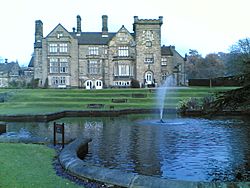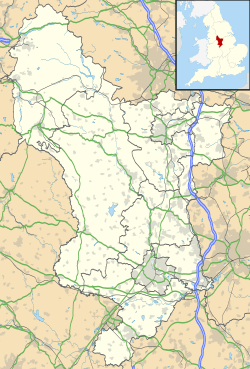Breadsall Priory facts for kids

Breadsall Priory in December 2005
|
|
| Monastery information | |
|---|---|
| Full name | The Priory of the Holy Trinity, Breadsall |
| Other names | Breadsall Park Priory |
| Order | Augustinian Canons |
| Established | Before 1266 |
| Disestablished | 1536 |
| Dedicated to | The Holy Trinity |
| Controlled churches | Breadsall, Duffield, Horsley, Mugginton and Windley. |
| People | |
| Founder(s) | Richard, Henry or Sir Robert Curzon |
| Site | |
| Coordinates | 52°58′07″N 1°26′08″W / 52.96862°N 1.43564°W |
| Grid reference | SK380414 |
| Visible remains | A single 13th-century arch remains from the original priory buildings, within the cellars of the later building constructed on the site. |
Breadsall Priory was once a small monastery in Derbyshire, England. It was home to Augustinian Canons, a type of religious group. The priory was built before 1266 by the Curzon family. It was closed down in 1536 during a time called the Dissolution of the Monasteries.
After the priory closed, the original buildings were taken down. A private house, also called Breadsall Priory, was built on the same spot. This house was changed and made bigger in the 1800s and 1900s. Today, only one old arch from the monastery remains, found in the cellars of the house. The house and its stables are now special "Grade II Listed" buildings, meaning they are protected for their history. The house is currently a hotel, and the stables are used as homes.
Contents
The Priory's Story
Breadsall Priory was started sometime before the mid-1200s. It was founded by a member of the Curzon family, possibly Richard, Henry, or Sir Robert Curzon.
Many people used to think Breadsall was home to "Augustinian Friars." This was because of a mistake made in an old record from 1266. However, Breadsall was actually home to Augustinian Canons. We know this because King Henry III gave the priory 20 acres of land. Augustinian Friars were not allowed to own land, but Augustinian Canons could.
A Small Community
Breadsall Priory was very small. Most of the time, only the prior (the leader) and two canons lived there. Sometimes, it was just the prior and one canon, or even just the prior alone. In 1291, the priory's yearly income was only about £5 19s, which was not much money.
Because there were so few canons, they couldn't choose their own prior. Instead, a member of the Curzon family, who were the "hereditary patrons" (meaning they had a special right to support and influence the priory), often chose the prior. The Curzon family were important landowners in Breadsall for many generations.
Changes in Ownership
Later, during the time of King Richard II (1377–1399), the land around the priory passed to the Dethick family. This happened when Cecilia Curzon married William Dethick. For a while, it wasn't clear who had the right to choose the prior. Sometimes, the Bishop of Lichfield made the choice. But in 1456, the bishop confirmed that Sir William Dethick had the right to choose a new leader when the priory needed one.
In 1402, William Dethick gave part of the church income from Mugginton to Breadsall Priory. However, he didn't follow the correct rules for giving away land. After he died, his family had to pay a large fine to the king.
Challenges and Support
In 1444, Breadsall Priory had a disagreement with the Collegiate Church of St Mary in Leicester. They argued over who owned the church taxes from a field called "Hethfield." The court decided that the field belonged to St Mary's.
In 1448, Prior Thomas Breadsall reported that some important papers belonging to the priory had been stolen. The bishop ordered that priests in local churches should announce the theft during church services. They said that anyone who didn't return the papers within 15 days would be excommunicated (removed from the church). We don't know if this plan worked.
In 1453, a man named John Statham agreed to give money to fix the roof of the priory church. In return, Prior Thomas Breadsall promised that the priory would hold a special church service every year for the souls of John Statham and his family.
In 1454, a canon from Breadsall named John Derby was given permission to travel around the area and preach in different churches. He was likely a very good speaker.
The Priory's End
By 1535, Breadsall Priory had a yearly income of about £10 17s. 9d after paying its costs. It also managed the churches in Breadsall, Duffield, Horsley, Mugginton, and Windley. At this time, only the prior, William Pendylton, lived at the priory.
Breadsall Priory was closed down in 1536 as part of the Dissolution of the Monasteries ordered by King Henry VIII. Prior Pendylton was given a small yearly payment of only 5 marks.
Today, only one arch from the original 13th-century priory buildings can still be seen. It is in the cellars of the house that was built later on the site.
Leaders of Breadsall Priory
Here is a list of some of the known priors (leaders) of Breadsall Priory:
- Hugh de Mackworth (appointed 1306)
- Hamund de Merston (appointed 1309, reappointed 1322)
- William de Repyndon (resigned 1347)
- Thomas de Castello (appointed 1347)
- Thomas de London (appointed 1365)
- Geoffrey de Stafford (resigned 1370)
- Thomas Lewes (appointed 1370)
- Roger Upton (appointed 1384)
- Thomas Holand (served 1431–1442)
- Thomas Beadsall (served 1442–1456)
- Robert Burton (served 1456–1487)
- Henry Halom (appointed 1487)
- John Alton (died 1519)
- Thomas Beyston (appointed 1519)
- William Pendyltion (last prior, present in 1535, surrendered the priory in 1536)
What Happened After the Priory Closed?
After Breadsall Priory was closed in 1536, some of its lands were given to another monastery called Darley Abbey. But Darley Abbey was also closed soon after, and the land then belonged to the King. The priory site itself was rented out by the King to Lawrence Holland in 1536. Later, the King gave the site to the Duke of Suffolk.
Over the years, Breadsall Priory has had many different owners. In the late 1500s, when Sir John Bentley owned it, a new house was built on the old priory site. This house, also called Breadsall Priory, was later changed and made bigger in 1861 and 1906. The stables next to the house were built in the mid-1800s.
Famous Residents
The famous doctor and poet Erasmus Darwin, who was the grandfather of Charles Darwin (the scientist who developed the theory of evolution), lived at Breadsall Priory shortly before he died in 1802. His son, Sir Francis Sacheverel Darwin, also lived there. Sir Francis's son, Edward Levett Darwin, who wrote a book about nature, learned a lot about natural history in the priory's grounds.
Later, a successful businessman from Derby named Sir Alfred Seale Haslam bought the house. He was the Mayor of Derby and a Member of Parliament. His son, Eric Seale Haslam, also held an important position in Derbyshire.
Breadsall Priory Today
Today, Breadsall Priory is a Marriott hotel. It has two 18-hole golf courses: one is called the Priory Course, and the other is the Moorland Course. In 2005, the priory hosted a meeting of important environment and development ministers from the G8 countries.
The main house was given a "Grade II Listed" status on September 2, 1952. This means it's a building of special historical or architectural interest. The stables, which are now used as homes, were also given "Grade II Listed" status on November 6, 1986.



